

Spent time with our #Cyanobacteria this morning @NHM_Botany, upgrading knackered folders etc as part of planning work to digitise this collection. Various curatorial tasks needed before a collection ready to digitise so helpful to be able to estimate how. So very satisfying to go from this to that (and means the specimen sheets are protected!)... and in case you're wondering, thats going to take about 12mins per shelf!
Best practices for digitizing a wood slide collection: The Bailey-Wetmore Wood Collection of the Harvard University Herbaria. 1.
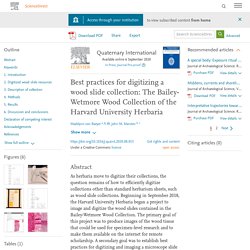
Introduction In the past 10–15 years, herbaria around the world have committed themselves to digitizing and imaging their collections to make them more accessible to the public (Nelson et al., 2015; Sweeney et al., 2018; Tegelberg et al., 2014; Thiers et al., 2016; Tulig et al., 2012). This has opened up collections that previously were only accessible on-site to researchers across the globe. The bulk of these digitization projects have focused on developing efficient digitizing and imaging protocols for herbarium specimen sheets to maximize the number of specimens digitized as quickly as possible with the highest accuracy (Nelson et al., 2015; Sweeney et al., 2018; Tegelberg et al., 2014; Thiers et al., 2016; Tulig et al., 2012). Herbarium collections, however, are not solely composed of herbarium sheets: they contain numerous subcollections that have unique scientific value, e.g. economic botany, historical wood slide, and paleobotanical collections.
Fig. 1. Fig. 2. Fig. 3. Picturae herbarium digitization : Digital herbarium conveyor belt. Technical capacities of digitisation centres within ICEDIG participating institutions. Digitisation Strategy 2020–2025 - Stacks. At Wellcome Collection, we digitise our historic collections to open them up to anyone, anywhere.
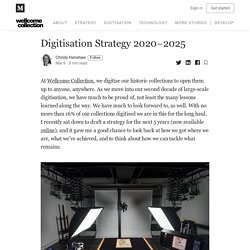
As we move into our second decade of large-scale digitisation, we have much to be proud of, not least the many lessons learned along the way. We have much to look forward to, as well. A complete digitization of German herbaria is possible, sensible and should be started now. Article metadata Introduction Botanical Collections in Germany Digitization of Herbaria in Germany Experiences and Achievements in other Countries Technical Components for Infrastructures of Scientific Collections Use Cases for an Infrastructure of Botanical Collections in Germany (and Beyond) Feasibility Conclusions References Endnotes.

Scientific user requirements for a herbarium data portal. ArticlesAbout About PensoftBooksE-BooksBlogJournals Register | Login Research Article.

Digital Collections Programme – Blogs from the Natural History Museum. In preparation of this blog I’ve been asking myself what, exactly, do I do for my job.
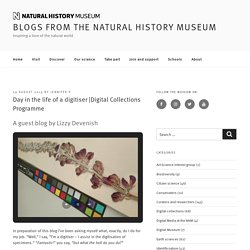
“Well,” I say, “I’m a digitiser – I assist in the digitisation of specimens.” “Fantastic!” You say, “but what the hell do you do?” How the RHS is digitising its plant archives for future generations. Digitization at NYBG. Posted in Garden News on July 23 2019, by Plant Talk Matthew C.

Pace, Ph.D., is an Assistant Curator at The New York Botanical Garden. Digitizing Specimens—Legal Issues Abound. Arctos – Collaborative Collection Management Solution. Arctos. Million dollar prize to improve insect imaging. A pilot for discovering plant diversity. Plants preserved as herbarium specimens provide the evidence of what plants there are, where they grow and when they were collected.

They provide the basis for modelling plant distribution over time, act as evidence that ensures plants are named consistently, and are a source of material for analyses of anatomy, disease and disease control, biochemistry and evolutionary relationships. Together, the herbaria at Kew and the Natural History Museum, London, contain more than 12 million specimens and are consulted by many visitors from around the world. This is how you photograph a million dead plants without losing your mind.
At the Smithsonian National Museum of Natural History, three young museum scientists have taken on the mind-numbing but important task of the digitizing millions of dried plant specimens.
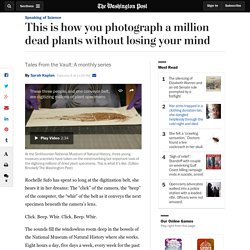
This is what it's like. (Gillian Brockell/The Washington Post) At the Smithsonian National Museum of Natural History, three young museum scientists have taken on the mind-numbing but important task of the digitizing millions of dried plant specimens. High Volume Digitization at the Smithsonian Museums. Less than 1% of the 138 million objects housed by the Smithsonian’s 19 different museums are on public display, with most of the collections hidden away in storage.

One increasingly common way to improve access is digitization: photographing, scanning, and web publishing to bring these hidden collections to light. A Novel Automated Mass Digitisation Workflow for Natural History Microscope Slides. Mass Digitizing a Working Herbarium using a conveyor belt: Workflows, Strategies, Challenges.
Please join us for Mass Digitizing a Working Herbarium using a conveyor belt: Workflows, Strategies, Challenges, a webinar presentation by Sylvia Orli, IT and Digitization Manager, US Herbarium (Smithsonian).
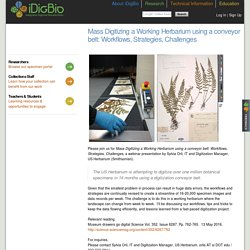
The US Herbarium is attempting to digitize over one million botanical specimens in 14 months using a digitization conveyor belt. Given that the smallest problem in process can result in huge data errors, the workflows and strategies are continually revised to create a streamline of 16-20,000 specimen images and data records per week. The challenge is to do this in a working herbarium where the landscape can change from week to week. I’ll be discussing our workflows, tips and tricks to keep the data flowing efficiently, and lessons learned from a fast-paced digitization project.
Relevant reading. How Lego lends a hand in digitising 300 year old Herbarium books. The Museum is on a mission to digitise 80 million specimens. We want to mobilise the collections to give the global community access to this unrivaled historical, cultural, geographical and taxonomic resource. Digitarium. Museum Specimens Find New Life Online. Advertisement Continue reading the main story Video. U WiSC: centralizing databases of 5 natural history museums. The fluorescence of certain minerals are visible when viewed under a mix of short- and long-wave “black light” sources in the rocks and minerals room at the Geology Museum.
A new initiative will centralize the databases of this and the university’s four other natural history museums. Photo: Jeff Miller. Microscope Slide Digitisation. We image each whole slide, capturing both the specimen(s) and the associated labels. By using additional temporary metadata labels we can encode information in Data Matrix barcodes about the taxonomy, type status and the slide’s location in the collection. These temporary labels enable us to create an inventory specimen record through semi-automated processes, which speeds up the process and reduces the potential for human error. Digitising Kew's microscope slide collection. Slide digitisation – what, why and how? One of the major elements of Kew’s Science Strategy 2015-2020 is the digitisation of Kew’s diverse collections.
Kew’s microscope slide collection is the largest of its kind worldwide, incorporating over 130,000 slides and representing a unique resource for trait analysis and plant authentication. The collection has been compiled over many decades, primarily from Kew's extensive living collections, herbarium collections and wood collection, but also from wild-sourced material and international exchanges. Joint digitisation projectNHM and Kew for legumes. Endless Forms TCN. Posted in Garden News on July 19 2019, by Plant Talk. Digitizing at Carnegie Museum. Digiitizing for phenology project. 1.4 million specimens to be digitised at the National Herbarium of NSW. Updated Sun at 12:15amSun 23 Dec 2018, 12:15am Plants that were salvaged after Captain Cook's Endeavour ran aground on the Great Barrier Reef nearly 250 years ago, will be photographed to create never before seen images in a permanent digital record.
Key points. Digitization, Central Siberian. Harvard: South American Phenology. Smithsonian Institution ArchivesAn Intern’s Guide on How to Digitize a Field Book. Herbarium Specimen Label Tutorial. A benchmark dataset of herbarium specimen images with label data. iDigBio modules: best practices for digitizing herbarium collections.
Toward a service-based workflow for automated information extraction from herbarium specimens. Databasing Herbarium Specimens and Ease of Use.